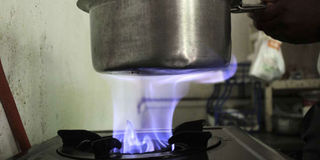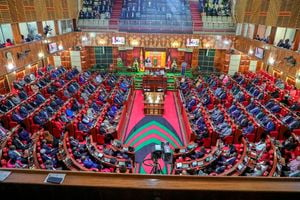Sick no more, thanks to biogas

Biogas is the sixth most commonly used cooking fuel in Kenya.
For 20 years, Naomi Tangus who lives in Kipsomor Village in Bomet Central, was one of the 55 per cent of Kenyans who rely on firewood for cooking. In Bomet County, where Ms Tangus lives, 17 per cent of residents use paraffin lamps for lighting, while 94 per cent use firewood for cooking, which exposes them to the risk of acute lower respiratory infections and pneumonia, especially in children. And so it was for the 36-year-old and her four children, who suffered persistent coughs that made them regulars at the local dispensary, where medics only prescribed medication and urged her to return if symptoms persisted.
Then four years ago, she dumped firewood for biogas and the hospital visits for respiratory problems disappeared. In 2015, through a government programme in partnership with the International Fund for Agricultural Development (IFAD), she got support to construct a four cubic metre biogas system because she had a zero-grazing unit for her two cows (but bought more material to make it an eight cubic metre system).
The family spent Sh85,000 on the project, and added 200 varieties of exotic and indigenous trees including fruit trees on one end of their farm for an added boost in environmental conservation after ditching firewood.
“I make sure that if I have de-wormed or vaccinate my cows, I dispose the cows' waste away from the system because the chemicals might kill or reduce the population of the micro-organisms that help make the gas and I will not get adequate gas,” she explains. The family uses slurry from the plant as fertiliser.
Before she set up the system, she would travel as far as Mau Forest to source for firewood, spending Sh1,000 for a tree that would provide fuel for two to four weeks and damaging the environment and her health in the process. Moreover, Ms Tangus told Healthy Nation that though the initial costs were hefty, biogas has proved more economical and less time-consuming allowing her to take 20 minutes to prepare meals instead of the previous one hour.
PUBLIC HEALTH CONCERN
In Borabu in Nyamira County, Elizabeth Orina, another beneficiary of the government programme, recounts how she used to develop eye irritation from cooking with firewood. She installed the biogas system in 2017 and her health changed for the better. Other beneficiaries of the biogas programme were drawn from Nakuru, Bomet, Nyamira, Kisii, Kakamega, Bungoma, Uasin Gishu, Nandi and Trans Nzoia, where there are many dairy farmers.
Exposure to indoor air pollution is still a major public health concern in Kenya, where unclean fuels are the most commonly used. Data from the Kenya National Bureau of Statistics shows that 55 per cent of Kenyans use firewood, 15 per cent use charcoal, while 14 per cent use paraffin, contributing to the burden of upper respiratory tract ailments and 14,300 deaths from air pollution (including indoor air pollution) every year.
During the 2009 census, 5.7 million Kenyans reported using firewood, 1.5 million said they use charcoal, while one million said they use paraffin. Most of them were residents of rural areas. In contrast, 438,381 Kenyans reported using LPG (gas), 70,433 reported using electricity, 63,356 said they use biogas and only 4,469 reported using solar, which are considered clean fuels that support good health and environmental conservation.
A few years later, the Kenya Integrated Household Budget Survey of 2015 conducted by KNBS found that fewer people were using paraffin for lighting than from the previous survey, and 41 per cent of households were using electricity for lighting. The survey also noted an increase in the use of solar for lighting, from two per cent in 2005 to 14 per cent in 2015. However, there were differences in the use of electricity for lighting, based on whether one lived in an urban or rural set-up. In urban areas, 73 per cent of residents used electricity versus 17 per cent in rural households. Nevertheless, the use of paraffin for lighting rural households dropped from 86 per cent to 49 per cent.
COOKING FUELS
For cooking, the use of LPG grew from nearly four per cent to 13 per cent, even though firewood, charcoal and kerosene continued to be the predominantly used cooking fuels. In rural areas, 84 per cent of households used firewood and only three per cent of households reported using clean energy. The use of unclean energy was further depicted in the type of cooking appliance used, with 46 per cent of Kenyans saying they used a traditional stone fire (72 per cent in rural areas, and 14 per cent in urban areas) and 14 per cent using a kerosene stove.
According to Kirtika Patel, the head of immunology at the Moi University School of Medicine, particulate matter such as polycyclic aromatic hydrocarbon (PAH) from the incomplete combustion of unclean fuels can exacerbate asthma symptoms especially in children.
Previous studies by researchers from Moi University indicated a link between oesophageal cancer and smoke from firewood.
One study on the cancer that is commonly diagnosed at the Moi Teaching and Referral Hospital in Eldoret, published in 2013, looked at risk factors for 159 patients at the hospital.
The study investigated the use of fuels such as firewood, charcoal, kerosene, gas and electricity and found that 44 per cent of the cases of oesophageal cancer were linked to the use of charcoal and firewood. The controls had a 26 per cent cancer rate.
CARCINOGEN
“Indoor air pollution from charcoal burning is a known human carcinogen, while that from biomass (primarily wood burning) is a probable human carcinogen.
“It contains many hazardous pollutants including known human carcinogens such as benzo(a)pyrene, formaldehyde and benzene,” explained Dr Patel, suggesting that long-term exposure to smoke from cooking with charcoal and firewood may be a risk factor for the incidence of oesophageal cancer, especially among people from low socio-economic backgrounds, who rely on unclean fuels, and go on to sleep in the polluted room where they cook. Data from the World Health organisation has also linked unclean fuels to heart disease and stroke.
The project that Ms Tangus and residents of nine counties benefited from aimed primarily to boost environmental conservation by reducing overreliance on wood fuel, according to project coordinator Moses Kembe, but it brought with it added health benefits.
“Biogas is the most innovative way to reduce the overreliance on the shrinking forest cover for firewood by conserving it,” Dr Kembe told Healthy Nation.
A Ministry of Devolution document on the implementation of Vision 2030 and the sustainable development goals published in 2017 noted that nearly six million Kenyans had been connected to electricity supply, marking 65 per cent access. However, the poorest 20 per cent of Kenyans were still left without electricity for lighting. The document also observed that 12 per cent of Kenyans relied on clean fuels and technology, leaving out a huge chunk at the mercy of the effects of unclean fuels. This informed the introduction of a gas project that was meant to increase LPG gas usage from 10 per cent to 26 per cent with a target of 10.6 million Kenyans using clean energy by the end of the implementation of the project.



